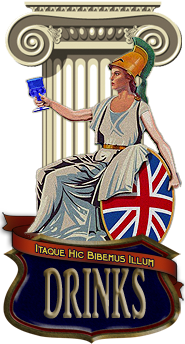 1 Cup uncooked long grain rice
1 Cup uncooked long grain rice
2 Quarts warm water
0.5 teaspoon ground cinnamon
1.25 Cups whole milk
1 (14 ounce) can sweetened condensed milk
1 teaspoon vanilla extract
2 oz+ Remy Martin Cognac
Mix the rice and warm water together in a bowl, and let stand for 1/2 hour.
Reserving the water, drain and place the rice in the bowl of a food processor. Add the cinnamon and process until rice is the consistency of a fine meal.
Return the rice to the water and let stand at least 2 hours, stirring occasionally as the water turns milky white.
Strain the rice through a fine sieve into a bowl or pitcher. Stir in the milk, condensed milk, vanilla, and cognac until evenly blended.
Refrigerate at least 2 hours.
Makes approximately 2.5 quarts
Tradition says to serve over ice. As this dilutes the drink, just keep it cold in the refrigerator and skip the ice. Stir before serving.
* * *
We all know the term “Napoleon complex” as a measure of feeling inadequate. Imagine then, if you will, what it must mean to suffer from said complex if you actually are Napoleon – but not the Napoleon. We’re talking Napoleon III, nephew to the real Napoleon. Much like Frank Sinatra Jr. was often referred to as Frank Not-So-Hotra (at least by my dad), being the other Napoleon must have come with its share of “not as great as his uncle” sentiment. But still, Bonaparte Lite had some mojo going for him, and he was dead set on showing France that he could lead it into a glorious new age. So, he did what any European-ruler-living-in-the-shadow-of-his-(in)famous-uncle would do – he got himself declared Emperor and began with the conquering… by invading Mexico.
Of course, Napoleon III had Mexico’s best interests at heart. Really – that was the plan. In 1894, the author Ulick Ralph Burke wrote, “For full fifty years of this Nineteenth Century the name of Mexico was almost synonymous with disorder and disgrace… A Mexican Bond was the type of financial worthlessness, a Mexican General was the type of military dishonor, a Mexican Statesman suggested recklessness, instability and fraud.” So, yes, from a European perspective, Mexico needed saving. Ravaged by war after war, Mexico was broke and couldn’t repay its foreign debts. But you couldn’t blame Mexican President Benito Juárez. Not only was his country broke, he was literally fighting for his job. See, Mexico in the mid-1800s was a battleground for conservatives (the military and the church) and liberals (those seeking reform), and Juárez (a liberal) was the first non-military, pure blood Indian to serve as leader of the country. Much like Mr. Lincoln up north, he was a simple, country lawyer. Of course, this only made him less popular with the opposition. And the opposition – General Juan Almonte (of Alamo fame), General Miguel Miramón (a former conservative “president” of Mexico), Archbishop Garza y Ballesteros, and Monsignor La Bastida (the next Archbishop) among others – were all in Paris, whispering in Napoleon’s ear about how the Mexican people would welcome his Catholic rule with open arms. Of course, they were just looking for a little help in ousting Juárez and his constitutionalists.
Since Mexico owed money to England and Spain as well as France, Napoleon convinced his compatriots that it would be a good idea to send a group of French soldiers over to Mexico and “have a talk” about its decision to suspend payments on all foreign debt. Fortunately, for France, Sir Charles Wake, British Minister, agreed that nothing short of a little naval action off of Tampico and Vera Cruz would bring the Mexicans to their senses. In October of 1861, the three nations signed the Tripartite Treaty of London, and by December, they had jointly landed troops in Vera Cruz.
At first, things went fine. The U.S. Diplomat to Mexico, Thomas Corwin, reported back to Secretary of State William H. Seward:
“The allies are encamped on the table-land, between Vera Cruz and Mexico. When the additional troops arrive, they will have from fifteen to twenty thousand. Thus far, not a hostile gun has been fired. The money demands of England are, in the main, if not altogether, just. I am not surprised that her patience is exhausted. Those of France are comparatively small, very small… These allies have said they came here to establish order. If the Church Party (Juárez’s opposition) is not put down very soon, France, and, perhaps Spain, will unite in restoring it to power, and their reason to the world will be, that peace must be given to disturbed Mexico.”
By April 1862, Mexico was trying to work out an arrangement with the U.S. for a loan to repay its debts, but the European alliance was quickly breaking down. England, France, and Spain each began to disagree over the treaty, and once suspicion of Napoleon’s true intentions were raised, the other two allies quickly withdrew their troops. The French declared a military dictatorship in Mexico, with General Almonte as Supreme Chief of the nation. They proclaimed “the French flag has been planted upon Mexican soil, and that flag shall not retrocede. Let the insensate dare to attack it!” War had begun.
Despite the edict of the Monroe Doctrine (1823), in which the United States said “stay out, Europe, or we’ll give you what for”, Napoleon was hedging his bets that the U.S. was too preoccupied by its own Civil War to mind someone poking around in Mexico. He wasn’t half wrong. Half of the United States sent support – the Confederate half, with a grand vision of how the Confederate government and Juárez’s liberal constitutionalist government were two peas in a pod. The Mexicans, however, smelled a Southern desire to expand further south – and they weren’t too keen on the slavery issue either.
In order to secure its claims, the French army had to take Mexico City, which Juárez and company had captured just the year before. One French division would march by way of Jalapa, another via Orizaba and Puebla. Of course, within Mexico, civil war was breaking out, as various generals and their loyal forces chose to side either with Juárez or with Almonte’s French army (known as the “Interventionists”). The French, of course, discounted the marshalling of local forces – as any army raised by the Mexican liberals would certainly be under-equipped and ill-prepared – and they expected their march to the capital to be met without resistance. All of that changed when they arrived in Puebla.
The day of the Battle of Puebla was, as you probably guessed, May 5, 1862. A rag-tag group of green Mexican recruits, under the command of the seasoned General Zaragoza and Porfirio Diaz (future Mexican president/dictator), held back an overwhelming number of highly-trained French soldiers. Reports claim that Zaragoza’s force were outnumbered 2-to-1. The battle lasted from dawn into the early evening, and when French General Charles Latrille de Lorencez’s forces finally retreated, they had lost 500 men in comparison to the Mexicans’ 100 casualties.
While the French defeat at Puebla did little to change the tide of the war – Napoleon III’s army returned, took Mexico City, and established the Second Mexican Empire with Archduke Ferdinand Maximilian of Austria on the throne as Maximilian I of Mexico. So maybe, the French did win in the end. If so, it was a short victory. By April of 1886, Napoleon had tired of his dalliances in the New World (Mexico was no better off for European rule and was still bankrupt) and announced a complete withdrawal of French forces by the end of 1867. In addition, with the Civil War now over, the United States recognized Juárez as the rightful leader in Mexico and was prepared to throw some weight behind the Monroe Doctrine. Emperor Maximilian knew that his days were numbered. By mid 1867, Maximilian was captured and executed, and Juárez was once again president of the nation.
So, now we get to the big question: why Horchata with Cognac? Ever seeking to find harmony and context in our drinks ingredients and the stories behind them, we thought nothing would capture the true meaning of Cinco de Mayo better than something French surrounded by something Mexican. If you’re unfamiliar with horchata, it’s a milky drink made from ground rice, seeds, or nuts. Like the French orgeat, its origins most likely date back to early milks made from barley. Cinnamon is the spice most typically added, although some recipes (like ours) also include vanilla, or other spices. While this recipe (borrowed from allrecipes.com; we replaced the Rum with Cognac) may be a little different than other traditional versions, it really is extremely light and delicious. As the recipe states, be sure to let the drink sit for a few hours before serving – it really lets the flavors meld – and consider the alcohol quotient a baseline. Add more as desired.
And there you have it, a drink that, unlike tequila shots or cervezas, truly captures the story behind Cinco de Mayo, a day when the Mexican people took a stand against oncoming European forces. If that isn’t something prototypically American, I don’t know what is.









































